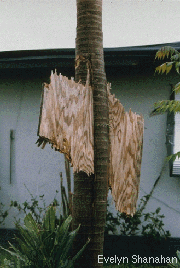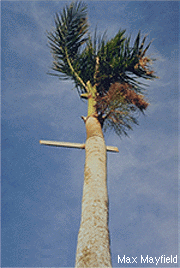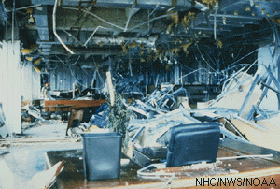|
 The intensity of
a landfalling hurricane is expressed in terms of categories that relate wind speeds and potential damage. According
to the Saffir-Simpson Hurricane Scale, a Category 1 hurricane has lighter winds compared
to storms in higher categories. A Category 4 hurricane would have winds between 131 and 155 mph and, on the
average, would usually be expected to cause 100 times the damage of the Category 1 storm. Depending on circumstances,
less intense storms may still be strong enough to produce damage, particularly in areas that have not prepared
in advance. The intensity of
a landfalling hurricane is expressed in terms of categories that relate wind speeds and potential damage. According
to the Saffir-Simpson Hurricane Scale, a Category 1 hurricane has lighter winds compared
to storms in higher categories. A Category 4 hurricane would have winds between 131 and 155 mph and, on the
average, would usually be expected to cause 100 times the damage of the Category 1 storm. Depending on circumstances,
less intense storms may still be strong enough to produce damage, particularly in areas that have not prepared
in advance.
 Tropical storm-force
winds are strong enough to be dangerous to those caught in them. For this reason, emergency managers plan on
having their evacuations complete and their personnel sheltered before the onset of tropical storm-force winds,
not hurricane-force winds. Tropical storm-force
winds are strong enough to be dangerous to those caught in them. For this reason, emergency managers plan on
having their evacuations complete and their personnel sheltered before the onset of tropical storm-force winds,
not hurricane-force winds.
Hurricane-force winds can easily destroy poorly constructed buildings and mobile homes. Debris such as signs,
roofing material, and small items left outside become flying missiles in hurricanes. Extensive damage to trees,
towers, water and underground utility lines (from uprooted trees), and fallen poles cause considerable disruption.
|
 The intensity of
a landfalling hurricane is expressed in terms of categories that relate wind speeds and potential damage. According
to the
The intensity of
a landfalling hurricane is expressed in terms of categories that relate wind speeds and potential damage. According
to the  Tropical storm-force
winds are strong enough to be dangerous to those caught in them. For this reason, emergency managers plan on
having their evacuations complete and their personnel sheltered before the onset of tropical storm-force winds,
not hurricane-force winds.
Tropical storm-force
winds are strong enough to be dangerous to those caught in them. For this reason, emergency managers plan on
having their evacuations complete and their personnel sheltered before the onset of tropical storm-force winds,
not hurricane-force winds.

